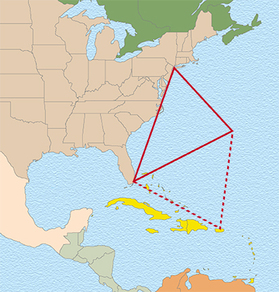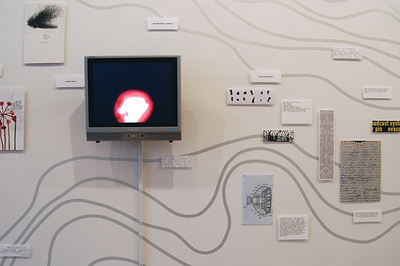|
Unfolding the
Triangle (NYC)
wall installation with videos, reflective tape and mixed media on paper installation view at 80WSE Galleries, New York, NY 2011 Unfolding the Triangle (NYC) explores location as a geographic, imaginary and psychological territory. The Bermuda Triangle, an area that encompasses the artist’s native Puerto Rico, becomes distended, its coordinates stretched and its area unfolded onto the exhibition site. A series of connections, multiple narratives, anamorphic forms, images and video screens are interwoven into an audiovisual mapping structure that explores navigation and displacement. This was the second installment of the Unfolding the Triangle series, which began with an installation at The Mattress Factory, Pittsburgh in 2009. Excerpt from “Subtle Intensities of the Unexpected”, a companion essay by Kathleen MacQueen for the exhibition By Chance, A Video Show, curated by Peter Campus at 80WSE Galleries: “In Nayda Collazo-Llorens’ Unfolding the Triangle (2011) the interstices begin to reveal themselves – topography, text, drawings, and video span across the wall as clues of a detective trying to solve a case. Past colludes with present, code mingles with description, and physical evidence confronts transcendental sensibility as she follows a trail of mysterious sightings, disappearances, accidents, and other untested phenomena within the triangle that alludes to the overlap between the artist’s own points of biographical connection and vectors of the notorious Bermuda Triangle, a loosely defined geographical region marred by unsolved crimes of natural or supernatural origin. Tape forms a reflective abstraction of the topography of the ocean floor providing an anamorphic grid to support the evidence as well as a directional narrative unfolding across time and space. Just as in the work of Jason Varone, humor and anxiety co-exist in the cumulative process of managing excess data comprising fact, mythology, and paranormal. Collazo-Llorens charts the space between event, perception, memory, and psychological recovery. Medium as Rosalind Krauss suggests is also the intermediary of communication between the subject and the unknown (either normal or parapsychology). Collazo-Llorens’s video component of three small screens the size of hospital monitors containing short loops of abstracted sound and blurred imagery gives the impression of how a patient coming out of a coma begins to make sense of the sensations that provoke consciousness. A friend once said to me, “I feel as if you are back.” Lying, I agreed for I only partially comprehended his suggestion. It would be in fact two more years before I was back and by then my world had changed irrevocably – I was alien to my own existence. Such upheavals occur when we withstand a shock – a bullet through the brain, a startling revelation, or a physical disturbance. We exist in altered form until another shock jolts our sensory receptors into recognition of a sterner but truer reality – an awareness of who we are in relation to others and the world that exists not for one but for all of us. This marks an end of the claim of narcissism on the soul and the end of video as defined by the psychological condition. Where is the space for failure, remorse, anxiety, and vulnerability in our interactions that connect us to each other? These positions are just as much part of what it means to be human as strength, resilience, and fulfillment, yet they isolate and provoke the construction of barriers both physical and psychological. Collazo-Llorens builds a text of alienation – of being alien – as an existential process of identifying what it means to be human. This unfolding of space between geographical coordinates is also an exposure of the vectors that chart personal experience. The term vector expresses a quantity with both direction and magnitude. It describes at once the course of aircraft, a gene transfer agent, and a disease-transmitting organism. Conceptually, a vector is an expansive movement, pulsing outward as a sound wave, a set of gestures, or a directional flow. It envelops as it unfolds suggesting the possibilities of abduction or simply the release from a constricting embrace.” MacQueen, Kathleen. “Subtle Intensities of the Unexpected.” By Chance, A Video Show. 80WSE Galleries, 25 Jan. 2011. Web. http://www.avideoshow.org/kathleen-macqueen |
|
|
_
|





